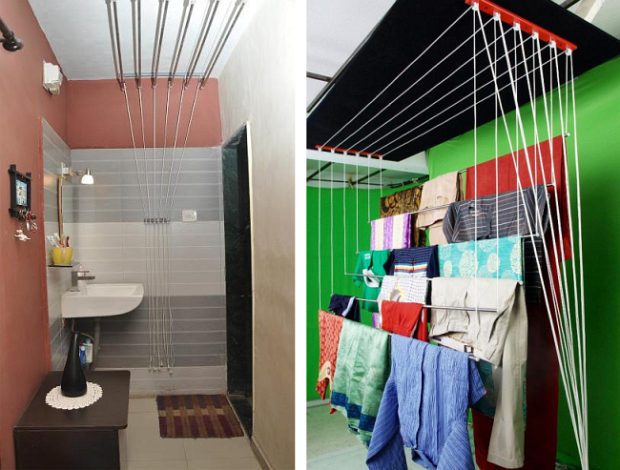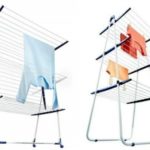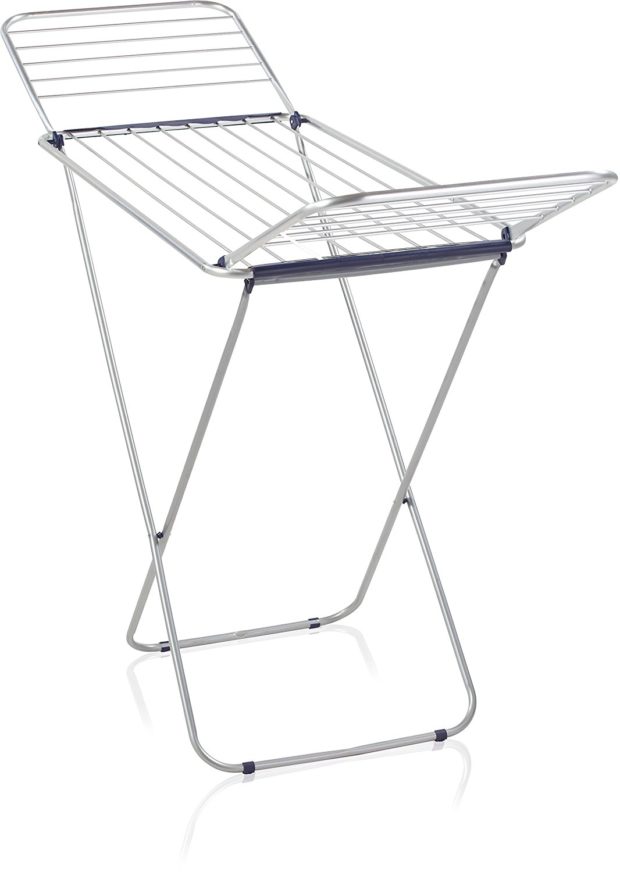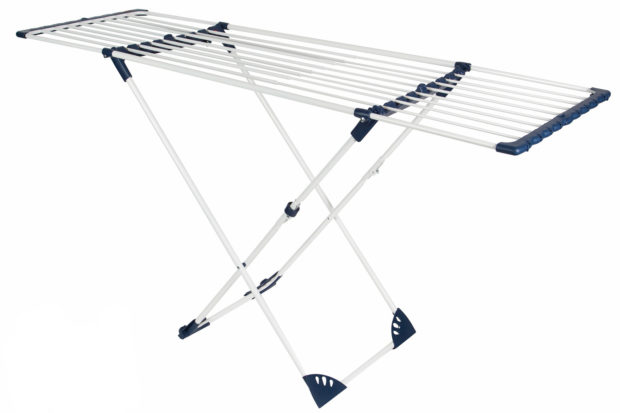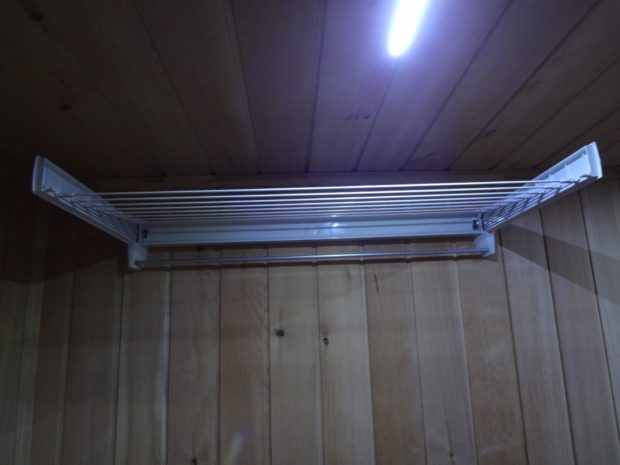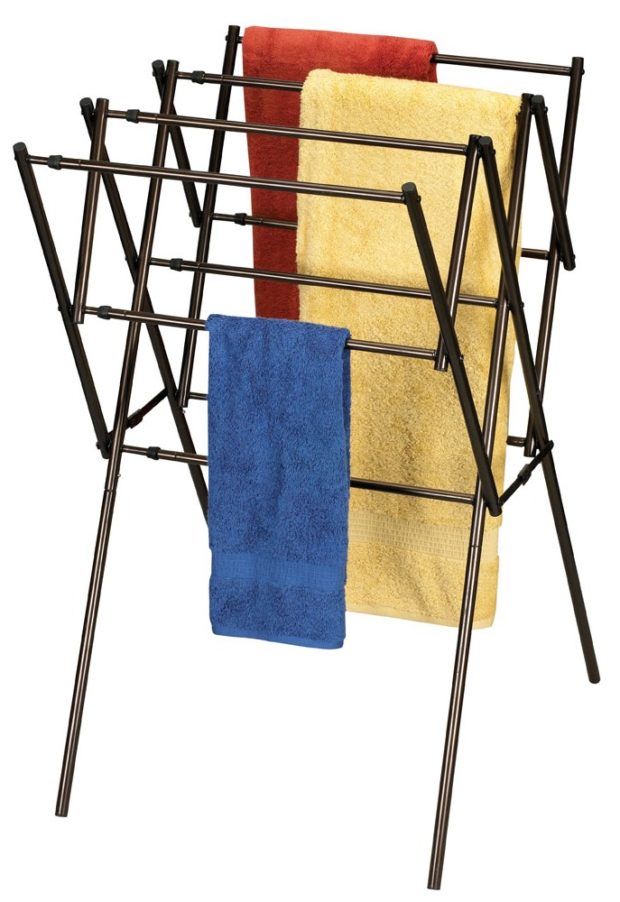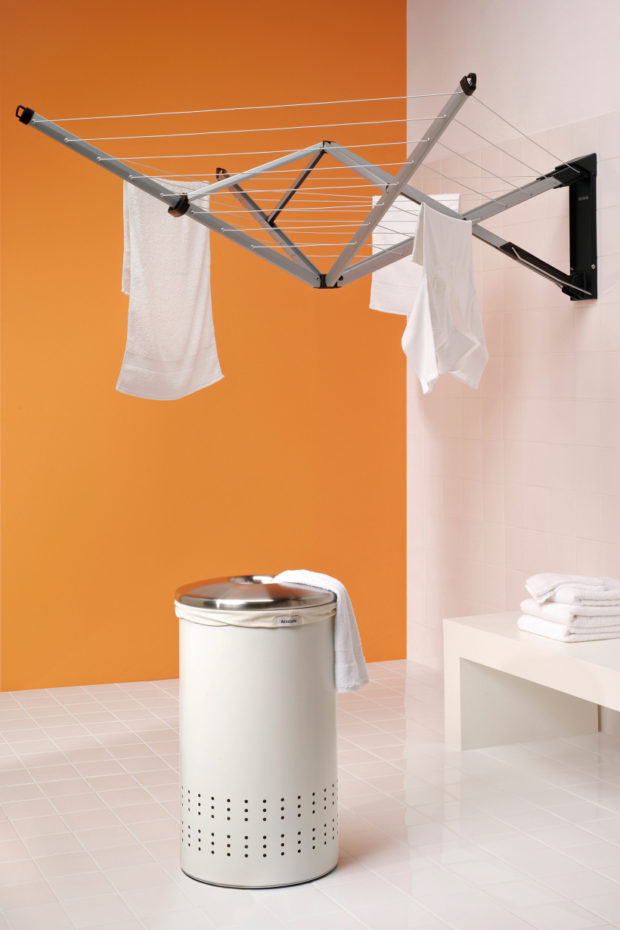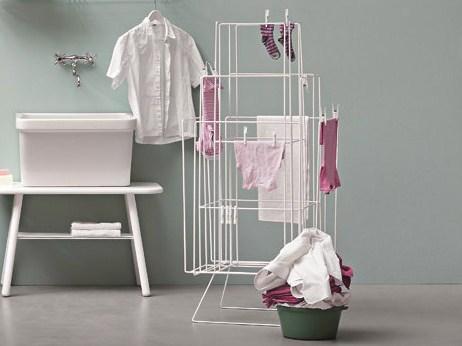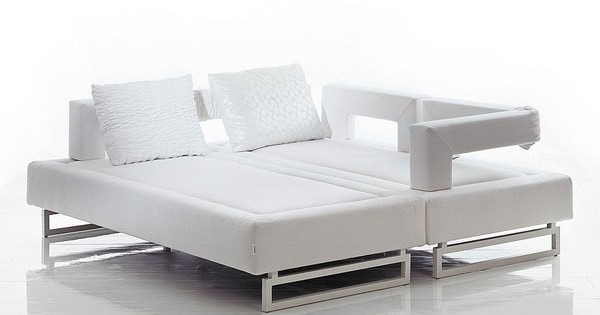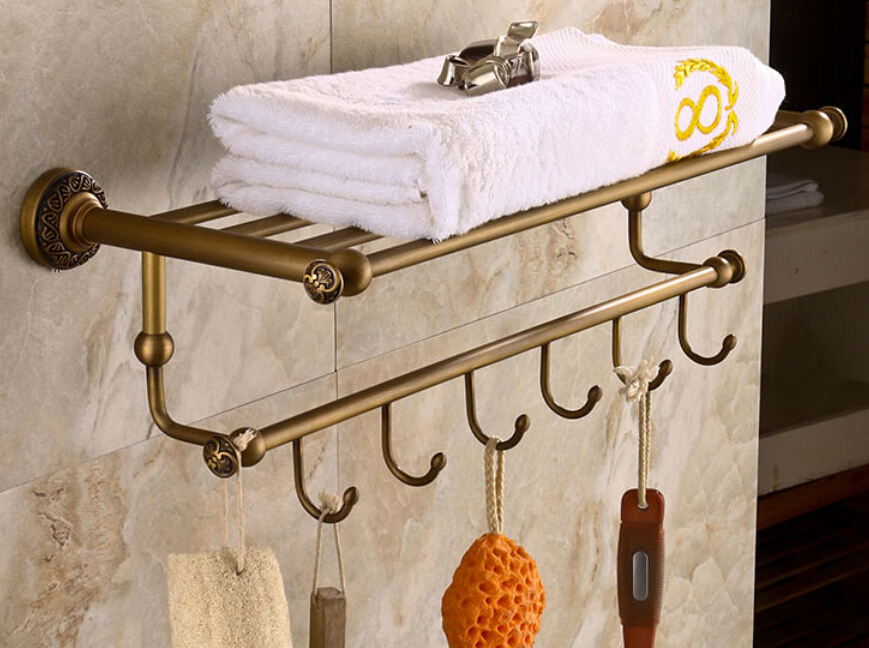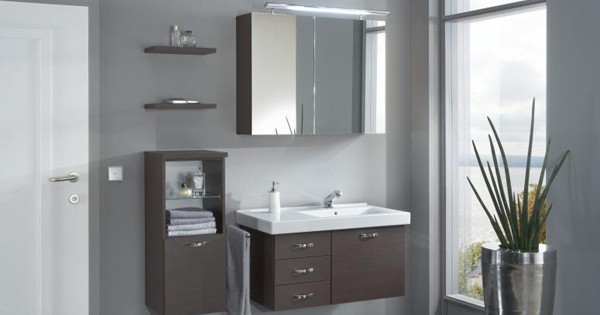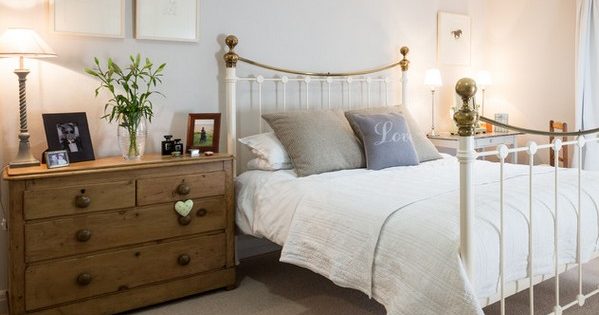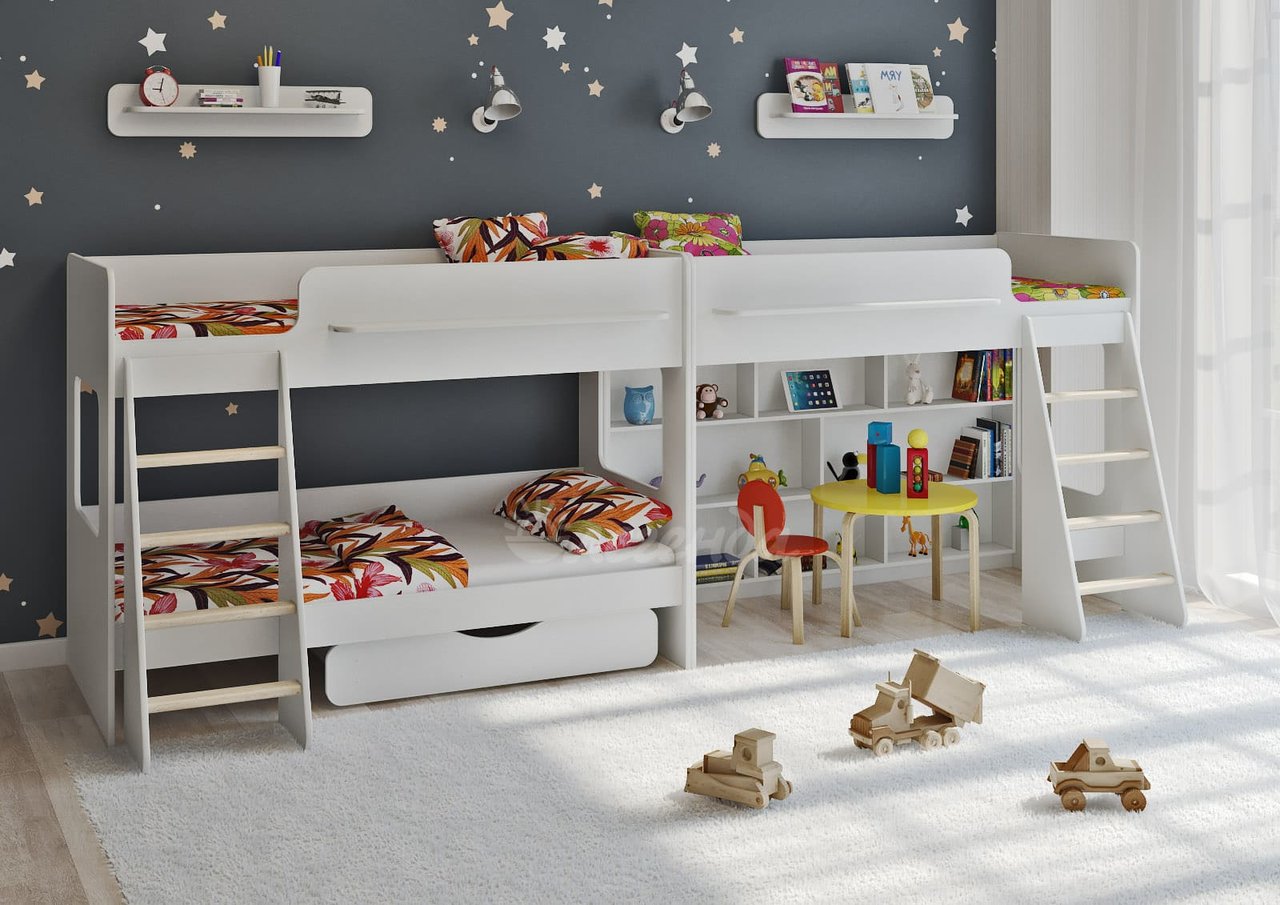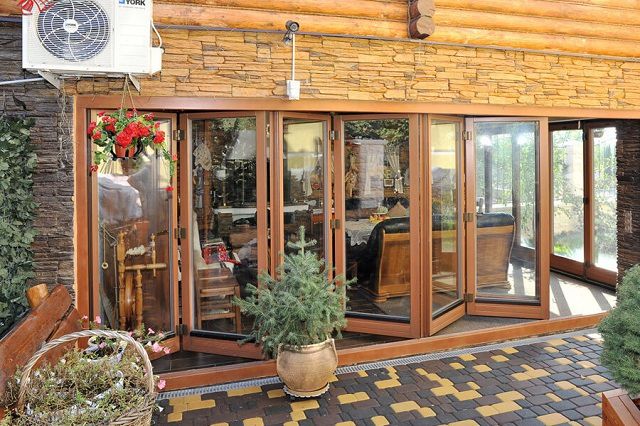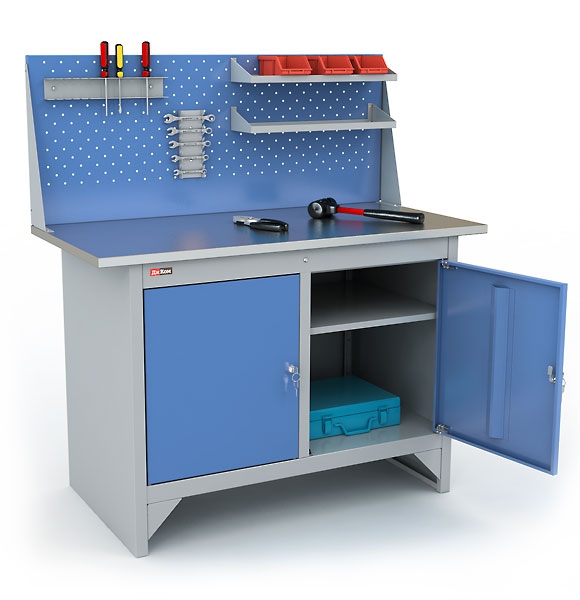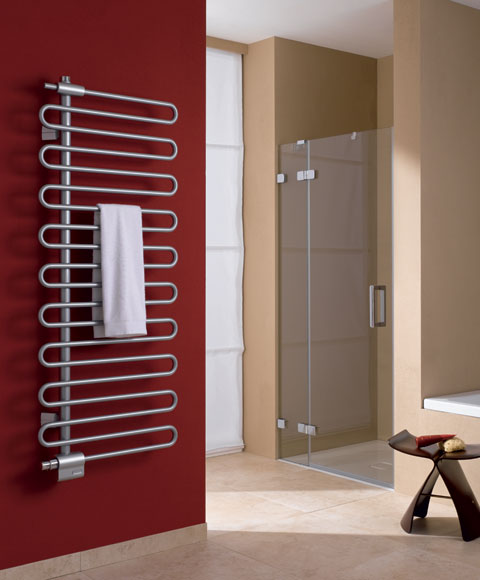10 tips for choosing a clothes dryer: types and options
Where to dry laundry at home, especially if the apartment is small? Conventional ropes are replaced by modern convenient devices that take up a minimum of space, but allow you to place a whole wash on them. Manufacturers offer us a huge number of different types of clothes dryers: floor, wall and ceiling, folding, sliding and stationary, with and without electric heating. Differences may relate to sizes, designs and materials. So how to understand all this abundance and choose the right clothes dryer? We study the market and make a decision.
No. 1. Types of clothes dryers by way of fastening
The easiest way to classify dryers by installation location is:
- wall mounted;
- Ceiling
- outdoor.
Separately still emit portable modelswhich can be fixed on any surface.
No. 2. Wall mounted clothes dryers
Most comfortable, practical and popular Today the option is wall-mounted dryers. They are installed on strong supporting walls and provide a sufficient amount of free space for the transformation of the dryer. These are compact models that save space, but some of them are not designed for heavy loads.
There are several variations of wall-mounted dryers:
- inertial folding dryers;
- accordion dryers;
- telescopic dryers;
- dryers of the "elevator" type;
- folding dryers;
- the most common stationary dryers.
Inertial Folding Dryers consist of two parts, which are installed on opposite walls. In one of the parts is a spinning drum with ropes, in the second - hooks. Ropes are pulled with very little effort and attached to hooks. The number of ropes in different models may vary. In the folded version, such a dryer takes up minimal space on the wall, and in the disassembled one it is a roomy device on which you can hang a decent amount of linen. This option can be called an improved analogue of the usual for us stationary ropes, which until recently adorned almost every the bathroom.
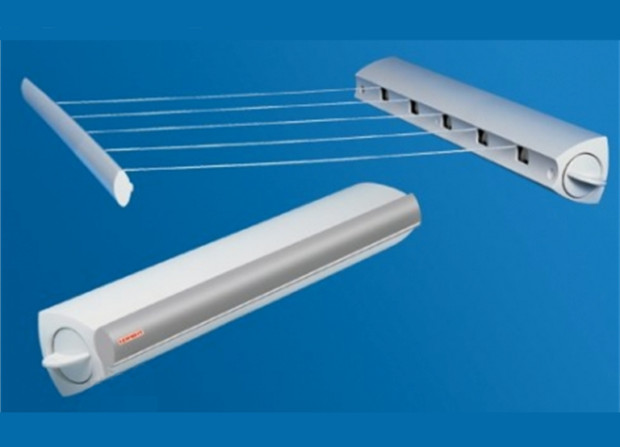

Sliding accordion wall dryer fastens only to one wall and, if necessary, can be moved forward thanks to a special mechanism that looks like an accordion. For hanging clothes instead of ropes or strings, tubes with a diameter of 1 cm are used here, so there will be no creases on the laundry. The number of tubes may vary and, as a rule, ranges from 5 to 10 pieces. Their width is from 50 cm to 1.2 m, so bed linen is not very convenient to dry on such devices. Assembled dryers occupy a minimum of space, are considered hardy and can withstand a decent weight of laundry. Such dryers are usually installed in bathrooms, much less often. on the balconies.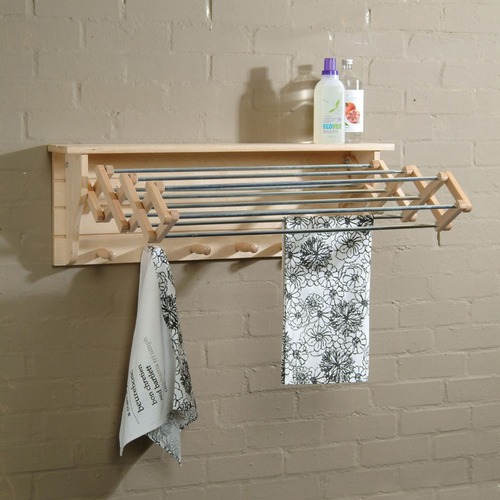
Telescopic dryers similar to accordions in that they also move forward, only the mechanism here is slightly different. It is possible to reveal them both completely and only partially. These are compact designs, but they do not support very much weight, they are suitable for drying underwear, shirts, blouses, socks and other light things.
Lift dryer - the most versatile model. It can be installed on the balcony and in the bathroom, takes up a minimum of space, but allows you to hang a large amount of linen. Some elements of such a dryer can be attached to the ceiling, so it is better to call this design ceiling-mounted dryer. A structure of two planks and several metal tubes (the standard number is 6) is attached to the wall, which, thanks to a special mechanism, can easily be lowered to the required height. This option allows you to lower the handset to conveniently hang the laundry, and then raise it to the maximum height so that the drying items do not bother anyone. Moreover, this mechanism allows you to dry things at different levels, providing them with the best ventilation. Each tube rises and falls independently of the others. Such dryers are also called "Vines". They are able to withstand weight up to 25 kg and are considered the most modern, thoughtful and comfortable.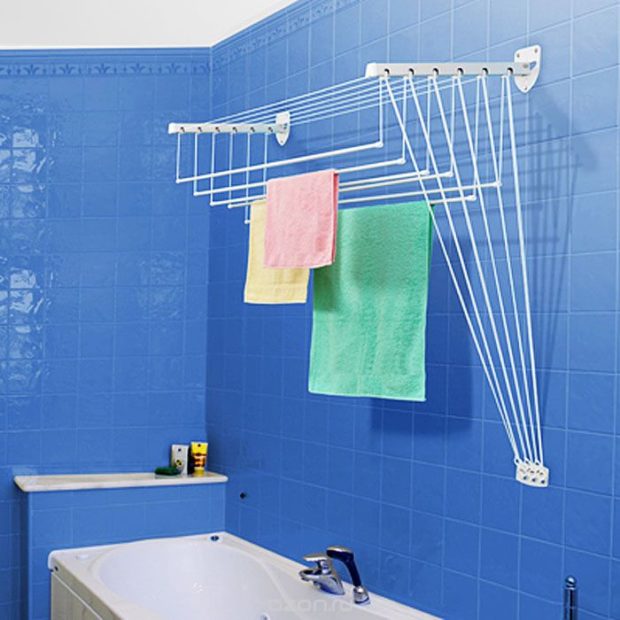
Folding Dryers have a fairly simple design, can withstand a decent weight. While there is no need for a dryer, it is attached to the wall and takes up a minimum of space, even less than usual heated towel rail. After washing, such a dryer is tilted, and the angle of inclination can be any. The process of folding and unfolding takes moments, it is convenient to use the dryer, the width and number of partitions can vary within wide limits. Usually they are installed in the bathrooms, but on the balcony they will be quite appropriate.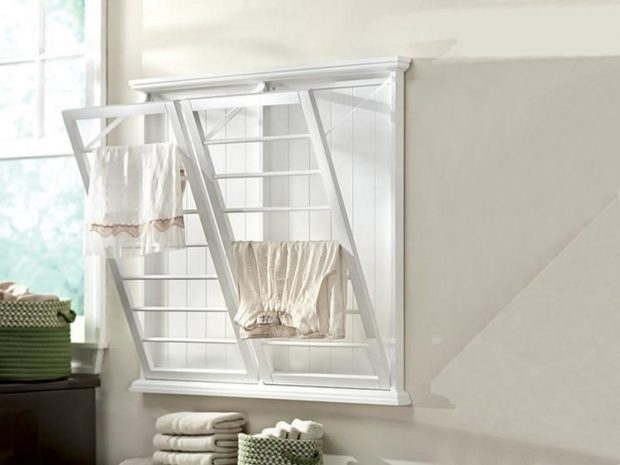
The simplest and most traditional option is stationary wall dryer for linen. If the apartment has a place, then two slats are fastened to the walls, between which the ropes are pulled. Previously, such designs adorned the entire bathroom, making it difficult for households to move around it, so today such dryers are mainly used on balconies and beyond balconies. Enhanced Option - Roller Dryer, which facilitates the process of hanging things if access to the entire length of the rope is complicated. Just pull the rope, and thanks to the rollers in the slats, it will easily move from place, and another part of it will move to you. Ideal for those who organize drying clothes outside the window or balcony.
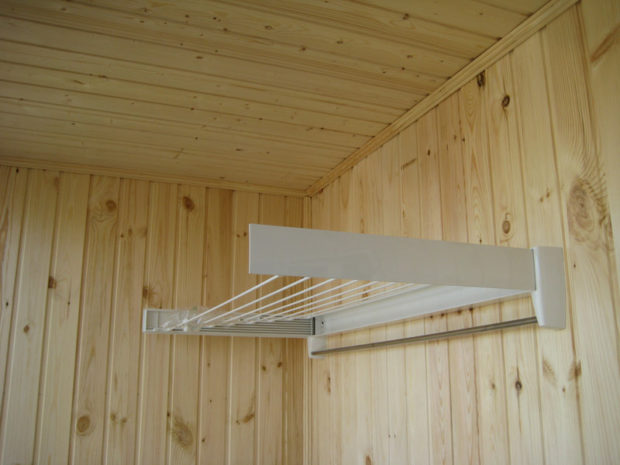
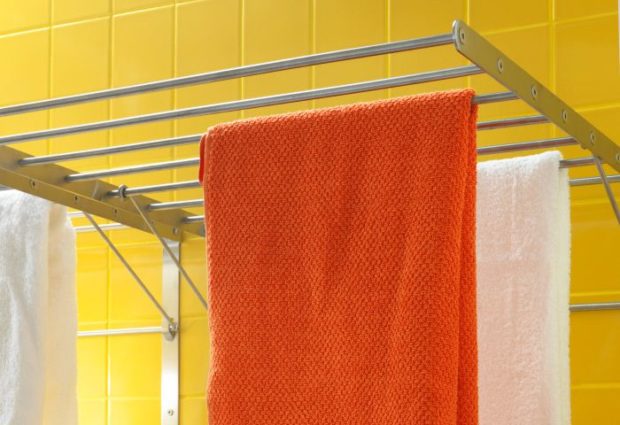

No. 3. Ceiling clothes dryers
Such designs can save space, but in the installation they are slightly more complicated than wall ones, therefore they are used less often. The following types of dryers can be attributed to ceiling:
- already mentioned dryers "lianas" with height-adjustable tubes. Trims can fixed to the ceiling, and then the dryer from the wall turns into the ceiling, but part of the design still has to be mounted on the wall for convenience (this is a block with ropes for controlling the height of the tubes);

- ceiling accordions. Here the principle, like with a wall accordion, only the dryer is installed on the ceiling and, if necessary, the unit with the crossbars for drying is pulled down and fixed at the required height. After hanging the laundry, it can be lifted so that things do not interfere with the free movement. In such dryers, both ropes and tubes can be used, and they are usually located at the same level. The dryer is compact, but large linen on it is difficult to dry;

- hanging clothes dryers - A primitive option for hanging the most compact and lightweight wardrobe items. Such a dryer looks like a hook with a strap installed on it, on which clothespins can be additionally attached. These are not very durable and durable dryers, usually made of plastic. Models made of metal and wood show themselves many times better.

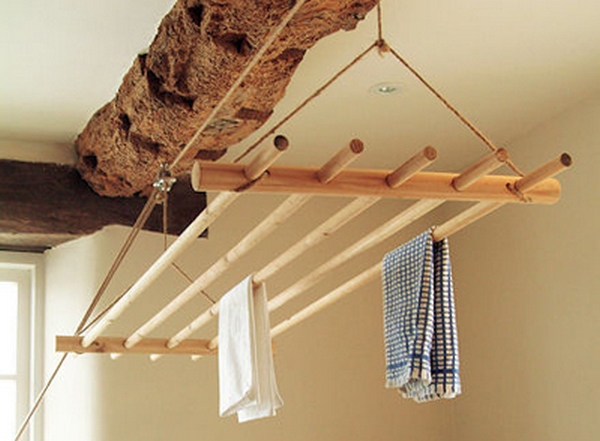
Variations in terms of design and size can be a lot.
Number 4. Floor clothes dryers
Floor-mounted sliding dryers are a great mobile option that can be installed anywhere, but when folded it takes up minimal space and can be easily hidden in wardrobe, pantry, wardrobe or even for some piece of furniture. Moving, disassembling and assembling such models is very simple; they can be completely different in size and layout.
TO the benefits floor dryers include mobility, ease of installation, a wide range, compactness when folded, and the ability to withstand heavy loads. The largest dryers, however, can weigh decently, but for ease of movement they are equipped with wheels.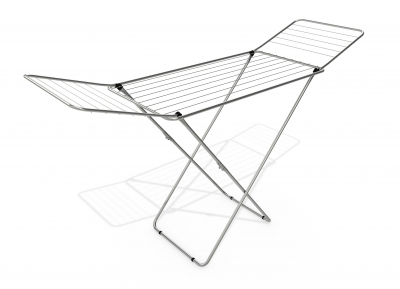
The simplest version of a sliding dryer is one that forms only one plane for hanging clothes with lots of ropes. In some designs, additional planes can be folded into the sides. Variations of designs invented an unlimited number. You can also find on sale vertical floor dryerswhere the planes are located one below the other. The height of such dryers is about 2 m, but can be adjusted, they are convenient to put in shower stalls.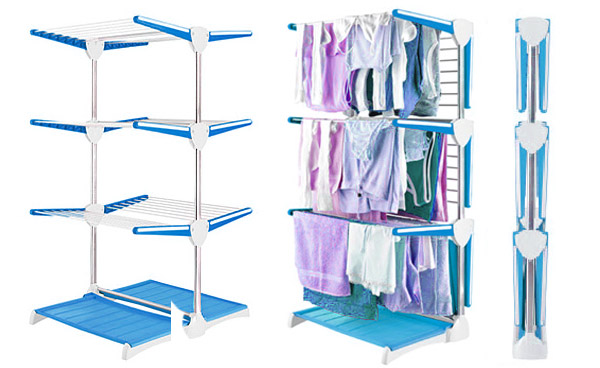
Designers, once embarked on the modernization of the design of floor dryers, offer us today a lot of interesting options that you can not even hide - they are unassembled without linen resembling some modern installations.
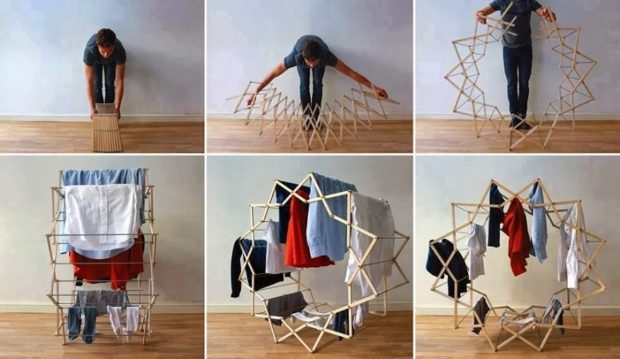
No. 5. Portable clothes dryers
Owners completely small apartments may pay attention to portable clothes dryers. They are compact in size, so you can install them anywhere: on the floor, on battery, at the door, to the bath. Portable dryers can be non-folding and folding. Hanging dryers described above can also be included in this category.
Portable dryers take up a minimum of space, and after the laundry dries, they can be easily hidden anywhere, but this is the main minus - many things at once will prevent this design from drying out.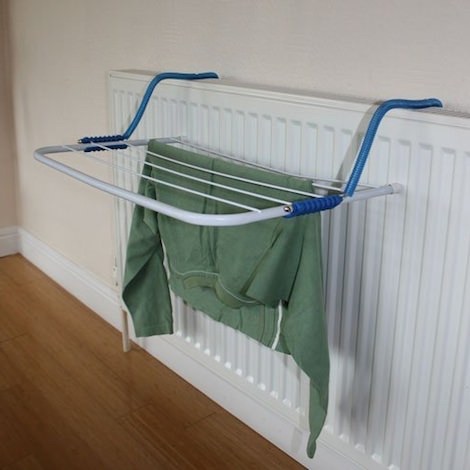
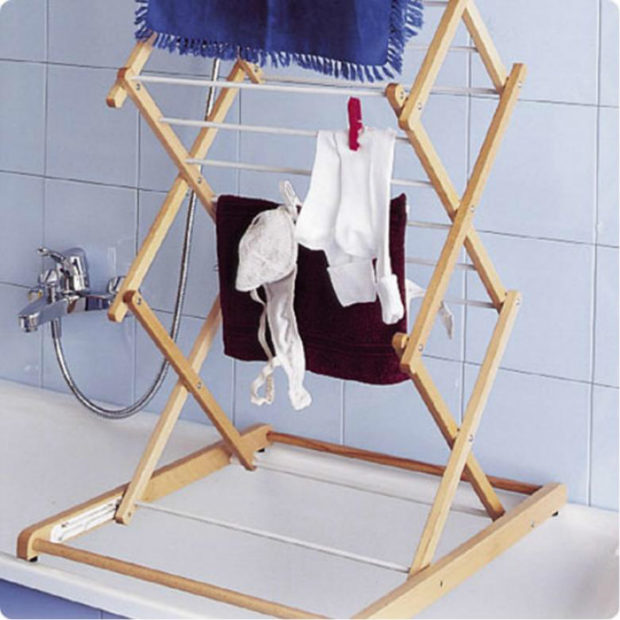
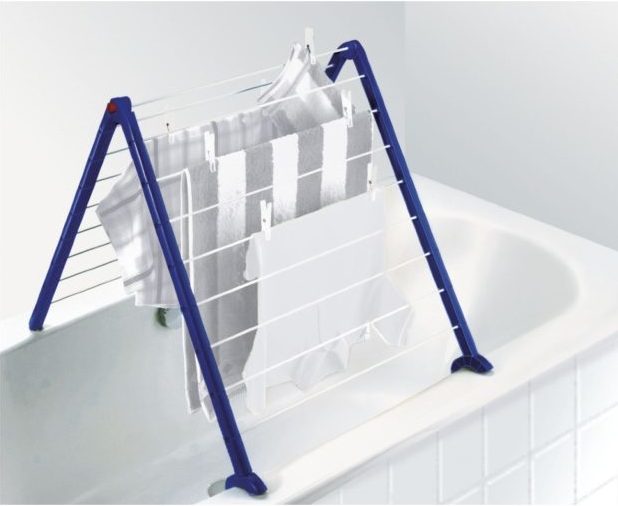
No. 6. Conventional and electric clothes dryers
In conventional dryers, things dry out naturally, in electrical processes accelerated by additional heating. For small apartments, where the dryer in disassembled condition can occupy up to half the room, accelerated drying will be a bonus. Among the others benefits of electric dryers:
- fabrics after drying have a pleasant fresh aroma, approximately as after drying in the fresh air;
- the ability to adjust the heating power;
- additional features like an ionizer or an ultraviolet lamp.

Among the shortcomings are only electricity consumption.
According to the principle of work such dryers can be divided into:
- models with heating rods. No matter how scary it may sound, the heating of the rods is such that it is not able to provoke a burn - this is about 50-600FROM;
- dryers with coverinside of which warm air circulates, which is ensured by the presence of a heating element and a fan. Such models allow you to dry not only clothes, but also toys, shoes, pillows and other products.
Electric dryers are also floor, wall and ceiling. Wall-mounted dryers are a lot like electric towel dryers, but usually involve a retractable design. External electric dryers externally practically do not differ from ordinary floor models, only if necessary they can be connected to the network and get additional heating.
Number 7. Other types of clothes dryers
Separately, it is worth highlighting dryers for delicate things. This is a grid stretched over a curved frame. On the grid, you can neatly lay out things that require specific drying conditions. Such a dryer can be installed on a bathtub, ironing board, table or on a conventional dryer, it provides gentle drying and air circulation.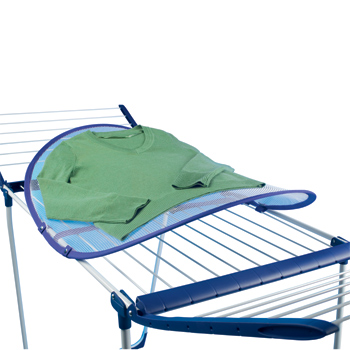
For the street invented a lot of options for dryers. As a rule, these are stationary structures that serve for years and require only periodic replacement of ropes or wires. Quite an interesting option - street folding dryer "umbrella", which, if necessary, opens up and forms a lot of space.
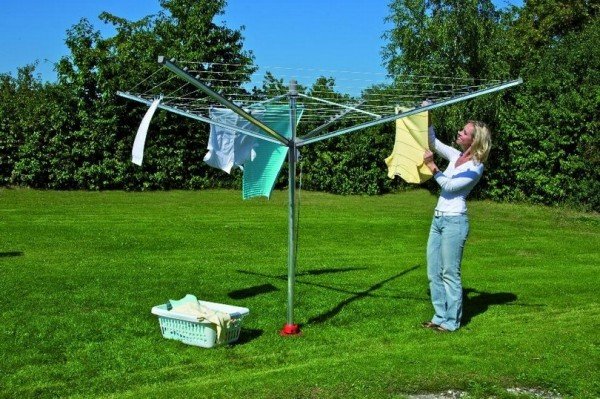
Number 8. Production material
When choosing a clothes dryer, the material of its execution plays a decisive role, affecting the durability, strength and resistance to moisture. Among the most popular options, we highlight:
- aluminum dryers light but may not be very stable. Over time, aluminum turns black and starts to get dirty, so manufacturers have learned to cover it polymer layer. This technique allows you to get rid of all the shortcomings, however, until a crack or chip appears on the coating;

- stainless steel - The ideal version of the dryer, both supporting structural elements and strings. The material does not rust, it is durable and durable. Among the minuses are a lot of weight (for floor dryers, by the way, this means increased stability) and cost;

- plastic dryers light, cheap, not oxidized, but short-lived. As a rule, only compact, portable, wall-mounted or wall-mounted models, which are designed for drying light products, are made of plastic. Floor dryers are less likely to be made plastic, but it will not work to hang a set of bedding and heavy sweaters on them;

- wood dryers They look good, but not very practical. So that they retain their original appearance for a long time, they will have to be regularly covered protective substances;

- combined models.
Strings for drying clothes can be made of thick durable thread or fishing line, an alternative is steel or aluminum tubes, which are better because they do not leave creases on clothing.
No. 9. Main characteristics of a clothes dryer
When buying a clothes dryer it is worth considering such important characteristics as:
- total work surface - this is the length of all the rods of the dryer in expanded form. The higher this indicator, the more massive and expensive the model will be;
- number of bars - an indicator that affects the width of the dryer;
- number of tiers. Multilevel dryers allow you to place a decent amount of laundry in a small space, they save space, but cost a lot. Floor dryers can have up to 4 tiers;

- maximum load depends on the type of construction and materials used, you should pay special attention to this parameter when choosing, so that the product lasts for as long as possible. Simple wall models withstand, as a rule, 5-10 kg of linen, wall-ceiling "creepers" and folding floor models - 20-25 kg;
- among additional options dryers worth highlighting shipping rollerswhich facilitate the movement of heavy floor structures. Castors are made of rubber, rubber and plastic. Rubber wheels can leave marks on the floor, plastic ones are unstable to mechanical damage, so plastic rollers with rubber coating would be the best choice. Wheels must be equipped clampso that the dryer is stable and does not roll anywhere. Useful add-ons also include special shoe drying compartmentshangers holders, protection against accidental closing (It is provided thanks to the clamps), as well as the installation function on the bath, which is implemented due to special devices on the legs of the dryer.

No. 10. What else to consider when choosing?
It would seem that everything has already been said, but in the end some more tipsthat will help you find the dryer that is ideal in all respects:
- when choosing necessary focus on the place where the dryer will be installed. Dryers “lianas” are perfect for balconies, they are also appropriate in the bathroom along with wall dryers, and floor structures are more suitable for living rooms;
- pay attention to the quality of the performance of all fasteners and ropes;
- the dryer must be kept clean and regularly wiped with a rag or sponge;
- among large dryer manufacturers We highlight the Swiss company Eurogold with its widest assortment, the Italian Foppapedretti, as well as Gimi, Hausmann, Leifheit, Marta, Zalger and Nika.

The design of the dryer also requires attention, and a pleasant surprise awaits us in this regard: in stores you can find both fairly simple, conservative models, and modern dryers in high-tech style, in appearance which you can immediately not even guess about the purpose.

